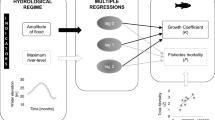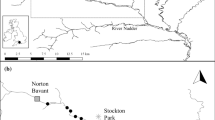Abstract
The mathematical and statistical advances in fitting stock assessment models enabled the emergence of the paradigm of “integrated analysis”, which fits all available data to a single model of population dynamics that traditionally has total catch as the only forcing function of the system. This approach, however, allowed us to include, in a flexible way, the effect of hydrological regime as an additional forcing function. We tried to achieve this flexibility by making the annual recruitment rates and spawning biomass adjustable to the attributes of the hydrological cycle data. Our models showed that these attributes are influential in the population dynamics of Brycon hilarii of the Northern Pantanal, and their inclusion in the models allowed best partial fits (which considered fits only to the data components length- and age-compositions, CPUE of juveniles and adults) than the Base-case (without hydrological attributes). The best partial fits where obtained when the attributes “delay of floods” and “intensity of floods” were forcing the spawning biomass and the annual recruitment respectively, indicating that these characteristics of the population may be influenced by specific attributes of the water level. The use of integrated modeling contributed with the advancement of population ecology knowledge of rheophilic fish. It is recommended that freshwater fisheries management be integrated into the hydrology management.















Similar content being viewed by others
References
Agostinho AA, Gomes LC, Zalewski M (2001) The importance of floodplains for the dynamics of fish communities of the upper river Paraná. Ecohydrol Hydrobiol 1(1–2):209–217
Agostinho AA, Gomes LC, Veríssimo S, Okada EK (2004) Flood regime, dam regulation and fish in the upper Paraná river: effects on assemblage attributes, reproduction and recruitment. Rev Fish Biol Fish 14:11–19
Agostinho AA, Gomes LC, Pelicice FM (2007) Ecologia e Manejo de Recursos Pesqueiros em Reservatórios do Brasil. EDUEM, Maringá
Alves DC, Minte-Vera CV (2012) Scientometric analysis of freshwater fisheries in Brazil: repeating past errors? Rev Fish Biol Fish. doi:10.1007/s11160-012-9282-6
Alves DC, Minte-Vera CV, Gomes LC, Dei Tos C, Agostinho AA (2011) Reconstruindo o passado: da distribuição de comprimentos atual aos recrutamentos históricos de peixes. In: XIII Congresso Brasileiro de Limnologia. Sociedade Brasileira de Limnologia, Natal
Antunes RSP, Gomes VN, Prioli SMAP, Prioli RA, Júlio HF Jr, Prioli LM, Agostinho CS et al (2010) Molecular characterization and phylogenetic relationships among species of the genus Brycon (Characiformes: Characidae) from four hydrographic basins in Brazil. Genet Mol Res 9(2):674–684
Arreguín-Sánchez F (1996) Catchability: a key parameter for fish stock assessment. Rev Fish Biol Fish 6:221–242
Arthington AH, Baran E, Brown CA, Dugan P, Halls AS, King JM, Minte-Vera CV et al (2007) Water requirements of floodplain rivers and fisheries: existing decision support tools and pathways for development. Comprehensive assessment of water management in agriculture Research Report 17. International Water Management Institute, pp 1391–9407
Bailly D, Agostinho AA, Suzuki HI (2008) Influence of the flood regime on the reproduction of fish species with different reproductive strategies in the Cuiabá river, upper Pantanal, Brazil. River Res Appl 24:1218–1229
Bayley PB, Petrere M (1989) Amazon fisheries: assessment methods, current status and management options. In: Dodge DP (ed) Proceedings of the international large river symposium, vol 106. Canadian Special Publications in Aquatic Science, pp 385–398
Béné C, Neiland AE (2003) Contribution of inland fisheries to rural livelihoods in Africa: an overview from the Lake Chad basin areas. In: FAO (ed) Proceedings of the second international symposium on the management of large rivers for fisheries, pp 67–77
Berkeley SA, Hixon MA, Larson RJ, Love MS (2004) Fisheries sustainability via protection of age structure and spatial distribution of fish populations. Fish Manag Feat 29(8):23–32
Brazil (2010) Boletim estatístico da pesca e aquicultura: Brasil 2008–2009. http://www.sepaq.pa.gov.br/files/u1/anuario_da_pesca_completo.pdf. Accessed 20 Sept 2011
Britski HA, Silimon KZS, Lopes BS (2007) Peixes do Pantanal: Manual de Identificação, 2nd edn. Embrapa Informação Tecnológica, Brasília
Carvalho AR, Williams S, Mariam J, Sowman M (2009) Reliability of community-based data monitoring in the Olifants River estuary (South Africa). Fish Res 96:119–128
Catella AC, Mascarenhas RO, Albuquerque SP, Albuquerque FF, Theodoro ERM (2008) Sistemas de estatísticas pesqueiras no Pantanal, Brasil: aspectos técnicos e políticos. Panam J Aqua Scie 3(3):174–192
FAO (2003) Review of the state of world fishery resources: inland fisheries. FAO Fisheries Circular No. 942, Rev.1 FIRI/C942
FAO (2010) The state of world fisheries and aquaculture. FAO, Rome
Ferraz de Lima JA (1981) A pesca no Pantanal de Mato Grosso (Rio Cuiabá: biologia e ecologia pesqueira). In: Anais do II Congresso Brasileiro de Engenharia de Pesca, Recife, pp 503–516
Ferraz de Lima JA (1986) A pesca no pantanal de Mato Grosso (rio Cuiabá: importância dos peixes migradores). Acta Amazonica 16:87–94
Fournier D, Archibald CA (1982) General theory for analyzing catch at age data. Can J Fish Aquat Sci 39:1195–1207
Girard P, Silva CJ, Abdo M (2003) River-groundwater interactions in the Brazilian Pantanal: the case of the Cuiabá River. J Hydrol 283:57–66
Harris MB, Tomas WM, Mourão G, Silva CJ, Guimarães E, Sonoda F, Fachim E (2005) Desafios para proteger o Pantanal brasileiro: ameaças e iniciativas em conservação. Megadiversidade 1(1):154–164
Hilborn R, Walters CJ (2001) Quantitative fisheries stock assessment: choice, dynamics & uncertainty, 3rd edn. Kluwer academic publishers, Boston
Junk WJ (1997) Structure and function of the large Central-Amazonian river-floodplains: synthesis and discussion. In: Junk WJ (ed) The central Amazon floodplain: ecology of a pulsing system. Springer, Berlin, pp 455–472
Junk WJ, Bayley PB, Sparks RE (1989) The flood pulse concept in river-flood plain systems. Can J Fish Aquat Sci 106:110–127
Junk WJ, Soares MGM, Bayley PB (2007) Freshwater fishes of the Amazon River basin: their biodiversity, fisheries, and habitats. Aquat Ecosyst Health Manag 10(2):153–173
Kinas PG (1996) Bayesian fishery stock assessment and decision making using adaptive importance sampling. Can J Fish Aquat Sci 53:414–423
Mace PM, Doonan IJ (1988) A generalised bioeconomic simulation model for fish population dynamics. New Zealand fishery assessment research document no. 88/4, Fisheries Research Centre/MAFFish: 21
Mateus LAF, Estupiñán GMB (2002) Fish stock assessment of piraputanga Brycon microlepis in the Cuiabá river basin, Pantanal of Mato Grosso, Brazil. Braz J Biol 62(1):165–170
Mateus LAF, Penha JM (2007) Dinâmica populacional de quatro espécies de grandes bagres na bacia do rio Cuiabá, Pantanal norte, Brasil (Siluriformes, Pimelodidae). Rev Bras Zool 24(1):87–98
Mateus LAF, Petrere M (2004) Age, growth and yield per recruit analysis of the pintado Pseudoplastystoma corruscans (Agassiz, 1829) in the Cuiabá river basin, Pantanal matogrossense, Brazil. Braz J Biol 64(2):257–264
Mateus LAF, Penha JM, Petrere M (2004) Fishing resources in the rio Cuiabá basin, Pantanal do Mato Grosso, Brazil. Neotrop Ichthyol 2(4):217–227
Maunder MN (2003) Paradigm shifts in fisheries stock assessment: from integrated analysis to Bayesian analysis and back again. Nat Resour Model 16(4):465–475
Methot RD (2005) Technical description of the stock synthesis II assessment program. Version 1.17. U.S. Department of Commerce: National Oceanic and Atmospheric Administration technical memorandum. SEDAR 16-AW-04
Mota SQ, Ruffino ML (1997) Biologia e pesca do curimatá (Prochilodus nigricans Agassiz, 1829) (Prochilodontidae) no médio Amazonas. Revis UNIMAR 19(2):493–508
Netto SL, Mateus LAF (2009) Comparação entre a pesca profissional—artesanal e pesca amadora no Pantanal de Cáceres, Mato Grosso, Brasil. B Inst Pesca 35(3):373–387
Netto MSS, Alves R, Figueiredo AC, Hino K (1993) Caracterização hidrogeoquímica da bacia do rio Mando-Cuiabá, Mato Grosso. Acta Limnol Brasil 6:230–244
Nilsson C, Reidy CA, Dynesius M, Revenga C (2005) Fragmentation and flow regulation of the world’s large river systems. Science 308:405–408
Okada EK, Agostinho AA, Suzuki HI, Ambrosio AM, Gomes LC (2010) Biologia pesqueira e pesca na área de influência do APM Manso: biologia, ecologia e socioeconomia—Relatório Final. Universidade Estadual de Maringá, Maringá
Parma AM, Deriso RB (1990) Dynamics of age composition in a population subject to size-selective mortality: effects of phenotypic variability in growth. Can J Fish Aquat Sci 47:274–289
Paugy D (2002) Reproductive strategies of fishes in a tropical temporary stream of the upper Senegal basin: Baoulé River in Mali. Aquat Living Resour 15:25–35
Pauly D (1980) On the interrelationships between natural mortality, growth parameters and mean environmental temperature in 175 fish stock. J Cons int Explor Mer 39:175–192
Penha JMF, Mateus LAF (2007) Sustainable harvest of two large predatory Catfish in the Cuiabá river basin, northern Pantanal, Brazil. Braz J Biol 67(1):81–89
Petrere M (1995) A pesca de água doce no brasil. Cienc Hoje 19(110):28–33
Quinn TJ (2003) Ruminations on the development and future of populations dynamics models in fisheries. Nat Resour Model 16(4):341–392
Ralston S, Ianelli JN (1998) When lengths are better than ages: the complex case of Bocaccio. In: Funk F, Quinn TJ, Heifetz J, Ianelli JN, Powers JE, Scheweigert JF, Sullivan PJ, Zhang CI (ed) Fishery stock assessment models. Alaska Sea Grant College Program Report, No. Ak-SG-98-01. University of Alaska Fairbanks, pp 451–468
Reys P, Sabino J, Goletti M (2009) Frugivory by the fish Brycon hilarii (Characidae) in western Brazil. Acta Oecol 35:136–141
Ruffino ML (1996) Towards participatory fishery management on the Lower Amazon. Bulletin 9(1):15–16
Severi W (1999) A pesca do rio Cuiabá: características e perspectivas. In: Ferreira MSFD (ed) O rio Cuiabá como subsídio para a educação ambiental. EDUFMT, Cuiabá, pp 63–102
Souza CA, Lani JL, Souza JB (2006) Origem e evolução no Pantanal mato-grossense. In: VI Simpósio Nacional de Geomorfologia, regional conference on geomorphology, Goiânia, pp 6–10
Suzuki HI, Pelicice FM, Luiz EA, Latini JD, Agostinho AA (2004) Reproductive strategies of the fish community of the Upper Paraná river floodplain. In: Agostinho AA, Rodrigues L, Gomes LC, Thomaz SM, Miranda LE (eds) Structure and functioning of the Paraná River and its floodplain: LTER-site 6. EDUEM, Maringá, pp 125–130
Suzuki HI, Agostinho AA, Bailly D, Gimenes MF, Júlio-Junior HF, Gomes LC (2009) Inter-annual variations in the abundance of young-of-year of migratory fishes in the Upper Paraná River floodplain: relations with hydroraphic attributes. Brazil J Biol 69(2):649–660
Ticheler HJ, Kolding J, Chanda B (1998) Participation of local fishermen in scientific fisheries data collection: a case study from the Bangweulu Swamps, Zambia. Fish Manag Ecol 5:81–92
Vazzoler AEAM (1996) Biologia da reprodução de peixes teleósteos: Teoria e prática. EDUEM, Maringá
Welcomme RL (1979) Fisheries ecology of floodplain rivers. Longman, London
Welcomme RL (1990) Status of fisheries in South American rivers. Interciencia 15(6):337–345
Welcomme RL, Halls A (2003) Dependence of tropical fisheries on flow. In: FAO (ed) Proceedings of the second international symposium on the management of large rivers for fisheries, pp 267–283
World Bank, FAO, World Fish Center (2010) The hidden harvests: the global contribution of capture fisheries. World Bank, Washington
Zhang C, Megrey BA (2006) A revised Alverson and Carney model for estimating the instantaneous rate of natural mortality. Trans Am Fish Soc 135:620–633
Acknowledgments
This work has been carried out with financial support from the Coordenação de Aperfeiçoamento de Pessoal de Nível Superior (CAPES), Núcleo de Pesquisas em Limnologia, Icitiologia e Aquicultura (Nupélia). The collection of data was funded by Furnas Centrais Hidrelétricas. We would like to thank Nupélia’s team for data collection and processing and the local agents, local fishermen and its representatives for collaborating with this research during field work. We would like to thank Tiago Balbi and Ângela Maria Ambrósio for gently providing their unpublished estimates of growth. We would like to thank Dr. Miguel Petrere Junior, Dra. Lucia Aparecida de Fatima Mateus, Dr. Luiz Carlos Gomes and two anonymous referees for thoroughly reviewing earlier version of the manuscript and providing valuable contributions. CVMV would like to thank Labpesq and Lipo of Oceanographic Insitute of University of São Paulo, where this manuscript was finalized.
Author information
Authors and Affiliations
Corresponding author
Electronic supplementary material
Below is the link to the electronic supplementary material.
Rights and permissions
About this article
Cite this article
Alves, D.C., Minte-Vera, C.V., Agostinho, A.A. et al. Hydrological attributes and rheophilic freshwater fish: stock assessment. Rev Fish Biol Fisheries 23, 375–394 (2013). https://doi.org/10.1007/s11160-012-9298-y
Received:
Accepted:
Published:
Issue Date:
DOI: https://doi.org/10.1007/s11160-012-9298-y




